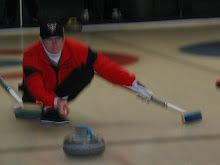 is for Measurement. Sometimes, when an end of curling is finished, it is difficult to tell just whose rock is closest to the center of the rings. If it is not possible to determine by eye, a measurement is necessary.
is for Measurement. Sometimes, when an end of curling is finished, it is difficult to tell just whose rock is closest to the center of the rings. If it is not possible to determine by eye, a measurement is necessary.
The most common curling measuring stick is a device with a pin at one end, that rests in a hole in the exact center of the rings, a straight rod which extends past the edge of the circles, and a moveable deflection lever attached to a scale of some description (see photo). The two rocks in question are measured in turn, and the vice-skips on each team must agree which rock is closer. If a determination cannot be made with the measuring stick, both rocks cancel each other out and are removed from play, neither scoring.
A second type of measuring device is the straight stick, that is exactly six feet long - the radius of the rings. It is used to determine if a rock right at the edge of the circles is, in fact, touching the rings. In general, measurements cannot be made until the last rock of the end has been played. There is one exception to this rule. In regards to the free guard zone rule, a rock may be measured before the fourth rock of an end has been played in order to determine if it is touching the rings or not - that is, to determine if it is in the house, and thereby able to be removed by another rock, or in the free guard zone, and protected against hits.
In general club and bonspiel play, measurements are conducted by the vice-skip of each team. In official events sanctioned by state/provincial or national associations, measurements are conducted by officials. By officials, of course, I mean volunteers who may or may not have received adequate training.
In one notorious incident during the 2002 Brier, an official attempted to measure a rock using a measuring device that was improperly set up, which resulted in them moving the rock they were trying to measure. As you can surmise, hilarity did not ensue. The end had to be replayed. Said the official involved (according to reliable sources), "it wasn't my fault."*
<- Start at the beginning.
*In fairness to the official in question, Joe Potter, he wasn't the one who assembled the measuring stick improperly in the first place. It's easy to say he should have noticed it wasn't set up correctly before he attempted the measurement, but those saying that have never had to perform a measurement in a game-on-the-line situation on national television before. I intended no disrespect to Joe with the last sentence of this entry. I just can't resist the opportunity to include a Star Wars reference in any blog post. My thanks to George Karrys of The Curling News, and TCN Blog for his research and remeniscences of the incident.







2 comments:
For years, as I watch curling on TV, I have wondered how precise is the measuring device. It obviously uses a strain gauge; surely it can detect a mm difference? What about .1 mm?
Hi Michael,
Thanks for the comment. I did not know the answer to your question, so I fired off an email to Kevin's Curling Supplies, in Edmonton, Alberta. I received a prompt reply from Kevin Martin himself, informing me that curling measuring devices - at least the ones he sells - can measure differences down to one-one thousandth of an inch (curling is an Imperial game, Kevin informs me). Doing the conversion, that is about 0.025mm, or one fortieth of a millimeter.
Think about that for a minute. We can measure two rocks' distance from the button in thousandths of an inch, and we still come across instances where a determination of who is "shot rock" is impossible to make. I think that's cool!
Post a Comment